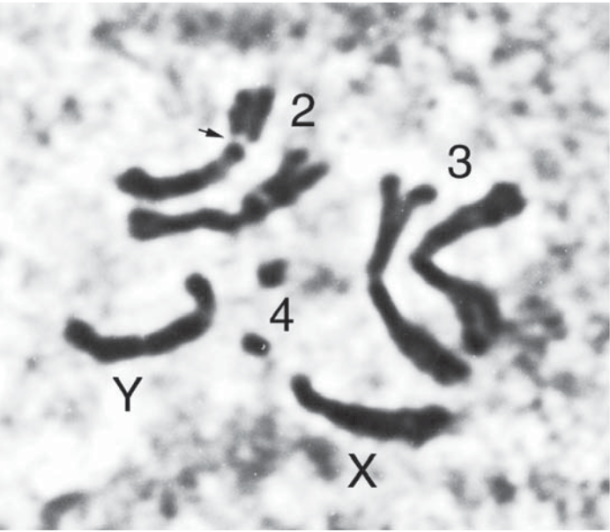When choosing a model organism, one of the main factors to consider is the complexity of the genome. How many genes does it have? How many non-coding vs. protein-coding sequences? How many chromosomes?
Four chromosomes
Drosophila melanogaster has four chromosomes, or more precisely, four pairs of chromosomes in each somatic cell: a pair of sex chromosomes (XX or XY in females or males, respectively), and three pairs of autosomes: 2, 3, and 4. In the below image you can see these four chromosome pairs neatly lined up during metaphase, in a cell from the male larval brain 👇

Edited by: D. S. Henderson © Humana Press Inc., Totowa, NJ
You may notice that Chromosome 4 is much smaller than 2 and 3. It has fewer genes than the other two autosomes and much more heterochromatin (transcriptionally silent DNA). Furthermore, it doesn’t undergo “crossing over” (recombination) during meiosis like Chromosomes 2 and 3.1 Consequently you will not find many, if any, genes of interest on Chromosome 4.
When working with D. melanogaster in the lab, you will discover a special system for naming chromosomes and the genes residing on them. Chromosomes 2 and 3 each have a “left” and “right” arm (denoted “L” and “R,” respectively) which refer to the genes located on either side of the centromere. For example, the left arm of the 2nd chromosome would be called “2L.” Chromosome 4, being so small, has no arms, and neither do X or Y.2 You can find maps of the D. melanogaster chromosomes (and a lot else) on Flybase, a great resource for fly biologists.

How many genes does D. melanogaster have?
Drosophila melanogaster has approximately 14,000 genes on its four pairs of chromosomes. To clarify, that’s ~14,000 protein-coding genes,3 in addition to a few thousand more “non-coding” genes that encode microRNAs or lncRNAs (more on those in a future article).
If you enjoyed this post on Drosophila melanogaster chromosomes, please check out my article on the Drosophila melanogaster lifecycle.
References
- Henderson D.S. (2004) The Chromosomes of Drosophila melanogaster. In: Henderson D.S. (eds) Drosophila Cytogenetics Protocols. Methods in Molecular Biology, vol 247. Humana Press. https://doi.org/10.1385/1-59259-665-7:1
- Flybase. http://flybase.org/
- UniProt: Proteomes – Drosophila melanogaster (Fruit fly). https://www.uniprot.org/proteomes/UP000000803
